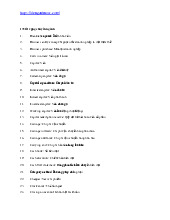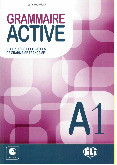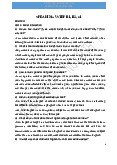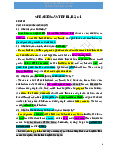














Preview text:
I. In linguistics, a corpus (plural corpora) is a large and structured set of texts (now usually electronically stored an
processed). A corpus may be used to help linguists to analyze a language, or for the purpose of dictionary writing
language teaching. The British National Corpus (BNC) is a 100-million-word text corpus of samples of written and
spoken English from a wide range of sources. The corpus covers British English of the late twentieth century from
variety of genres with the intention that it be a representative sample of spoken and written British English of that 1. What is a corpus? A. A type of large dictionary B. A single written text
C. A tool for language analysis 2. Why was the BNC compiled?
A. For the purpose of language teaching.
B. To document written and spoken English from a particular period in time.
C. To document the history of the English language.
II. The term ‘learning styles’ refers to a variety of ways of learning. The ‘learning styles’ theory is based on the
observation that most people prefer an identifiable method of interacting with, taking in, and processing stimuli or
information. The idea of individualized ‘learning styles’ originated in the 1970s and acquired enormous
popularity. Proponents say that teachers should assess the learning styles of their students and adapt their classr
methods to best fit each student’s preference.
The basis and efficacy of these proposals are extensively criticized. Although children and adults express persona
preferences, there is no evidence that identifying a student’s learning style produces better outcomes, and there is
significant evidence that the hypothesis (that a student will learn best if taught in a method deemed appropriate fo
her learning style) may be invalid.
1. The idea that people should learn according to their preferred learning style
A. has influenced all teachers.
B. became popular around 40 years ago. C. has never been disputed. 2. There is no evidence that
A. people have learning preferences.
B. the hypothesis might be wrong.
C. it is beneficial to identify students’ preferred learning styles.
III. The term “IQ” comes from German “Intelligenz-Quotient”, coined by the German psychologist William Stern in
1912, who proposed a method of scoring children’s intelligence tests. Since the early 20th century, scores on IQ tests hav
increased in most parts of the world. The phenomenon of rising score performance means that if test-takers are s
a constant standard scoring rule, IQ test scores have been rising at an average rate of around three IQ points per This phenomenon was the Flynn named
effect in the book The Bell Curve after James R. Flynn, the author who d
most to bring this phenomenon to the attention of psychologists. 1. “IQ” refers to
A. a type of intelligence test for children.
B. a means of rating intelligence tests. C. an area of psychology. 2. Flynn noticed that
A. IQ scores were constant around the world.
B. IQ was a global phenomenon.
C. intelligence scores had gradually risen over several decades.
IV. The ethos of the aristocracy, as exemplified in the English public schools, greatly influenced Pierre de Coubert
The public schools subscribed to the belief that sport formed an important part of education, an attitude summed u
the saying ‘mens sana in corpore sano’, a sound mind in a sound body. In this ethos, a gentleman was one who becam
all-rounder, not the best at one specific thing. There was also a prevailing concept of fairness, in which practicing
training was considered tantamount to cheating.
1. De Coubertin agreed with the idea that
A. sport is an activity for gentlemen.
B. schooling should promote both physical and mental health.
C. sport is the most important part of a child’s education. 2. In De Coubertin’s view
A. it is easier to be good at many sports, rather than the best at one sport.
B. training is necessary if you want to be an all-rounder.
C. training gives the athlete an unfair advantage.
V. A placebo is a sham or simulated medical intervention. Sometimes patients given a placebo treatment will have
perceived or actual improvement in a medical condition, a phenomenon commonly called the placebo effect.
A study of Danish general practitioners found that 48% had prescribed a placebo at least 10 times in the past yea
most frequently prescribed placebos were antibiotics for viral infections and vitamins for fatigue. Specialists and h
based physicians reported much lower rates of placebo use.
1. The placebo effect refers to
A. a simulated medical treatment.
B. an improvement in a patient’s health as a result of a simulated medical treatment.
C. a common medical phenomenon.
2. According to a study, placebos were prescribed in Denmark
A. mainly by doctors working in hospitals. B. instead of antibiotics.
C. for fatigued patients or those suffering from viruses.
VI. The cinematograph is a motion picture film camera which also serves as a film projector and developer. It was
invented in the 1890s, but there is much dispute as to the identity of its inventor.
Some argue that the device was first invented and patented as “Cinématographe Léon Bouly” by French inventor Léon
Bouly on February 12, 1892. Bouly coined the term “cinematograph”, which translates in Greek to “writing in
movement”. It is said that Bouly was not able to pay the rent for his patent the following year and that the brothers:
Auguste and Louis Lumière bought the license.
A more popular version of events is that Louis Lumière was the first to conceptualize the idea. The Lumière brothe
shared the patent, and they made their first film, Sortie de l’usine Lumière de Lyon, in 1894.
Choose the best title for the whole passage from the list below.
A. How the cinematograph was invented B. The first film projector
C. Who invented the cinematograph? D. What is a cinematograph?
VII. The attitude of the scientific community towards the unconscious mind has shifted dramatically in recent years
While once viewed as a lazy reservoir of memories and non-task-oriented behavior, the unconscious is now regar
an active and essential component in the processes of decision-making.
Historically, the unconscious mind was considered to be the source of dreams and implicit memory (which allows
to walk or ride a bicycle without consciously thinking about the activity), as well as the storing place for memories
experiences. But recent research reveals that the unconscious brain might also be an active player in decision ma
problem-solving, creativity, and critical thinking. One familiar example of the operation of the unconscious in probl
solving is the well-known phenomenon of the “eureka moment” when a solution to a problem presents itself without the
involvement of active thinking.
Which is the best title of the paragraph?
A. Scientists present new findings of the unconscious mind.
B. Our growing understanding of the role of the unconscious C. How humans solve problems
D. What is a “eureka moment”?
VIII. Ecotourism is a form of tourism where tourists visit fragile, pristine, and relatively undisturbed natural areas. I
purpose may be to educate the traveler, to provide funds for ecological conservation, to directly benefit the econom
development and political empowerment of local communities, or to foster respect for different cultures and for hu rights.
However, ecotourism operations occasionally fail to live up to conservation ideals. Even a modest increase in pop
puts extra pressure on the local environment and necessitates the development of additional infrastructure. The
construction of water treatment plants, sanitation facilities, and lodges come with the exploitation of non-renewabl
energy sources and the utilization of already limited local resources. The environment may suffer because local
communities are unable to meet these infrastructure demands.
1. One aim of ecotourism is to
A. allow people to visit areas that were previously restricted.
B. educate local communities in fragile areas.
C. raise money for environmental projects in natural areas.
2. However, ecotourism can cause problems when
A. the local population does not welcome visitors.
B. extra facilities and amenities are required to cope with a population increase.
C. communities do not have the funds to improve local facilities.
IX. In many industrial or manufacturing workplaces, managing hazards is essential for a successful health and saf
system. Hazard management is an ongoing process that goes through five different stages, with each step becom
stage on a tire hazard management plan. The first step is to identify potential hazards, remembering that hazards
classed as anything that could potentially cause harm not only to people but also to the organization. To illustrate,
industrial accident can cause an injury to employees, but can also result in lost production, broken machinery, and
resources for the company, In many cases, local and national government legislation has strict regulations concer
hazard identification, and in many industries, especially those perceived to be dangerous, severe penalties can be
by companies overlooking such hazard identification. Questions:
Choose answers from letters A-D next to questions 1-5.
1. Why is managing hazards essential in industrial or manufacturing workplaces?
1. For well-being and protection of the workers 2. For health reasons 3. For workplace safety 4. All the above
2. According to the passage, how many stages should hazard management undergo? 1. Five distinct stages 2. More than five stages
3. Almost five different stages
4. More or less than five stages
3. What is the first step of a hazard management plan?
1. Evaluate the risks involved 2. Analyze the harm 3. Both A & B
4. Recognize the risks involved
4. What are the risks involved in an industrial accident? 1. Injuries to the workers
2. Enormous impact on the economy 3. Loss of productivity 4. Both A & C
5. According to the passage, on what basis has the government imposed strict regulations on the industries?
1. Danger to the life of workers 2. Failing to observe hazards 3. Recognition of threats 4. None of the above Is violence innate?
In 1983, archaeologists in southern Germany discovered a mass grave containing 34 skeletons. They included
males, 7 adult females and 16 children.
All of the skeletons showed signs of fatal trauma, including head wounds. None of them showed any signs of
defensive wounds, suggesting they were killed whilst running away.
The "Talheim Death Pit" dates from the Stone Age, around 7,000 years ago. It offers some of the oldest eviden
organised group violence between two communities: that is, of war.
Clearly, humans have been fighting wars for thousands of years, and we may not be the only ones. There is gr
evidence that several other species also engage in warfare, including our closest relatives the chimpanzees.
That suggests we have inherited our predilection for warfare from our ape-like ancestors. But not everyone agr warfare is inbuilt. Choose the correct letter, , A B, C or D.
1. What did archaeologists in southern Germany discover? A. Remains of 34 dead animals
B. Graveyard containing 34 skeletons
C. Relics of early civilization
D. 9 adult males, 7 adult females and 16 children
2. Why did scientists suggested that those people were killed whilst running away?
A. Their skeletons showed signs of fatal trauma B. There were 16 children C.
During that period organised group violence was very frequent D.
Their skeletons didn't show any signs of defensive wounds
3. Why do human beings fight, according to the article? A.
Because they have been fighting wars for thousands of years B.
Because chimpanzees, who are humans' closest relatives, engage in warfare C.
Because humans inherited predilection for warfare from their ape-like ancestors D.
Because fighting is their inbuilt instinct
4. Which of the fol owing phrases best describes the main aim of the Reading Passage?
A. To describe fighting among different species
B. To intoduce principles of contemporary archaeology and its application
C. To introduce some relics of humans' warfare for further discussion whether violence is innate or not
D. To suggest ways of interperting humans' violence
August 1985: The worst month for air disasters
There are many grim landmarks in the history of aviation. One in particular stands out. Three decades ago, 720 tr
and crew lost their lives on board commercial aircraft in a single month - more than in any other before or since.
The deaths occurred in four separate accidents in August 1985. Each disaster had quite different causes. The airc
involved ranged from a 747 with hundreds on board to a tiny twin engine turboprop carrying just eight people.
There was Japan Air Lines flight 123, the worst single-aircraft accident in history, in which 520 of 524 on board we
killed. A further 137 died when Delta flight 191 flew into heavy winds as it approached Dallas-Fort Worth Internatio
A fire on board British Airtours flight 28M at Manchester Airport led to 55 deaths. And all those on board the smalle
aircraft, Bar Harbor Airlines flight 1808, lost their lives as it flew into a small airport in Maine, USA.
Each, in their own way, had a lasting legacy, whether in the memories of those left bereaved or in changes in tech
and procedure introduced as a direct result. The worst death toll was on Japan Air Lines Flight 123, a Boeing 747
was en route from Tokyo to Osaka on 12 August 1985 when the airtight bulkhead between its cabin and tail tore o
The change in pressure blew off the vertical stabiliser, or tail fin. It also destroyed the hydraulic systems. The plan lurched up and down. Choose the correct letter, , A B, C or D.
1. When did the 720 travellers die? Show hint A. Thirteen decades ago. B. A few decades ago. C. 30 years ago. D.
There is no information about it.
2. Twin engine turboprop could carry A. Eight people B. Four people C. Two people D. Only a pilot
3. The worst accident in history, according to the paragraph, was: A. Flight 123 B. Delta flight 191
C. British Airtours flight 28M.
D. Bar Harbor Airlines flight 1808.
4. Why did the Japan Air Lines Flight 123 crashed?
A. The change in pressure blew off the vertical stabiliser.
B. Destruction of the hydraulic systems.
C. The airtight bulkhead between its cabin and tail tore open. D. It is unknown.
Why does coffee shoot out of the lid of your cup?
You're running late for work and you've purchased your coffee in a hurry. Just as you arrive at the office, a jet of h
liquid escapes from the tiny hole in the lid, leaving you with hot beverage residue on your clothes before the day h really started.
TThis is exactly what happened to Rob Kaczmarek after buying a cup of his favourite caffeinated drink. The marke
director at Convergent Science was intrigued by why the coffee shoots out so far and therefore set about modellin
initially as a joke for those who enjoy a bit of computational fluid dynamics. It's the design of the lid that's the prob he explains.
"It happens because of the sloshing of the coffee against the lid, which is kind of unique. At the end of the lid, the
right up above that. As the coffee sloshes against the end of the lid, that velocity is amplified and it splashes up th the actual hole."
Not al coffee cups are designed with a hole, of course. Some have lids with a tiny hole and others peel back to re
much larger gap, which offsets the shooting jets of hot liquid. Choose the correct letter, , A B, C or D.
1. What accident might occur at work in the morning, after you bought coffee?
A. You spill it all over the place accidently.
B. You get burns from the hot coffee.
C. You contaminate your clothes with it. D. Nothing out of ordinary.
2. Rob Kaczmarek explains to us that:
A. The coffee shoots out very far.
B. He sat his experiment as a joke.
C. He was really intrigued by spilling the coffee.
D. Coffee spils because of the design of the lid.
3. The main reason coffee spils is: Show hint A. Velocity. B. Sloshing. C. Design of the cup. D. It is not stated.
4. This text might be classified as: A. Scientific. B. Humorous. C. Fictional. D. Romantic.
1. Young children are making criminologists nervous because
(a) they are committing too much crime.
(b) they are impulsive and immature.
(c) they may grow up to be criminals.
2. The general crime rate in the US is (a)increasing (b)decreasing (c)not changing
3. The age group which commits the highest rate of crime is (a)14 - 17. (b)18 - 24. (c)24 +.
4. James Fox believes that the improvement in crime figures could
(a)make us complacent in the fight against crime.
(b)result in an increase in teenage violence.
(c)result in a decrease in teenage violence.
5. According to paragraph 3, the government
(a)is doing everything it can to solve the problem.
(b)is not interested in solving the problem.
(c)is not doing enough to solve the problem.
6. In comparison with James Fox, Michael Tonry is (a)more pessimistic. (b)less pessimistic. (c)equally pessimistic.
7. Jonathan Kozol believes that
(a)there is no solution to the problem.
(b)employment and education are not the answer.
(c)employment and education can improve the situation.
8. Professor DiIulio thinks that spending on social programs (a) should continue as it is (b)should be decreased.
(c)is irrelevant to crime rates.




